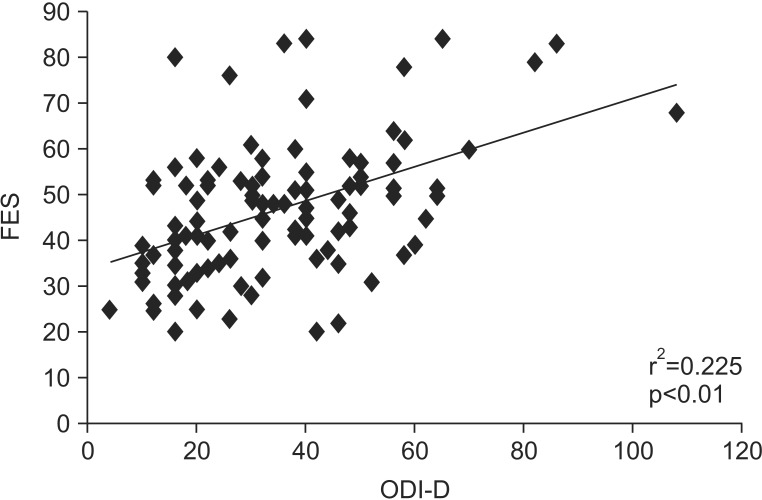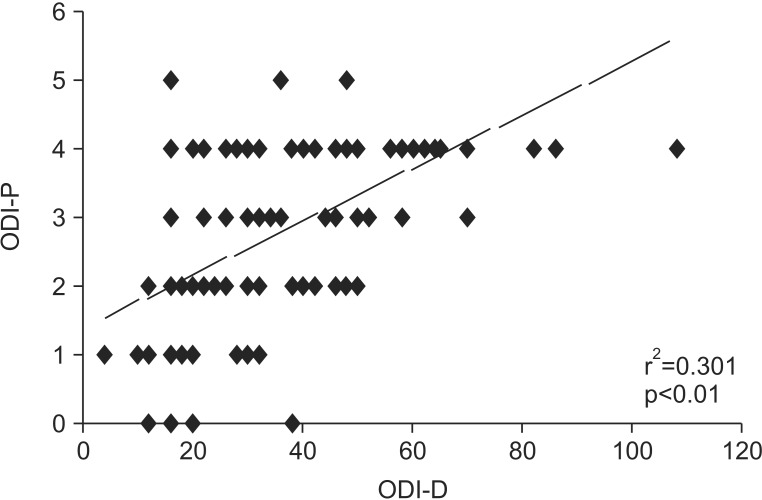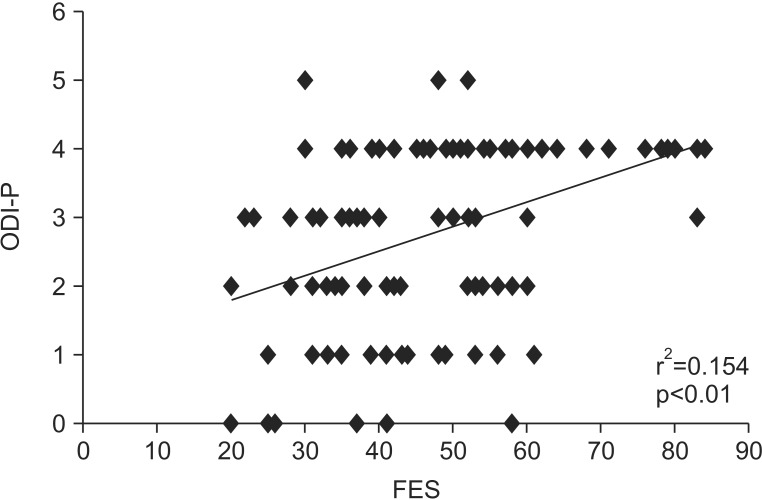Ann Rehabil Med.
2015 Oct;39(5):816-820. 10.5535/arm.2015.39.5.816.
Correlation Between Pain, Fear of Falling and Disability in Low Back Pain
- Affiliations
-
- 1Department of Physiotherapy, Lala Lajpat Rai Hospital, Kanpur, India. vermasadhana85@yahoo.com
- 2Department of Physiotherapy, Saai College of Medical Science and Technology, Kanpur, India.
- KMID: 2148213
- DOI: http://doi.org/10.5535/arm.2015.39.5.816
Abstract
OBJECTIVE
To ascertain if there is a correlation between low back pain (LBP), fear of falling, and disability so that the patients with LBP are aware of the fact that other problems may occur with LBP. Hence, steps can be taken for decreasing the fear of falling and disability in order to improve the condition of patients.
METHODS
A sample size of 100 patients with low back pain, with a range of ages from 40 to 73 years, participated in the study. The Falls Efficacy Scale was used to assess the fear of falling and the Oswestry Disability Index was used to assess the disability and pain in LBP individuals.
RESULTS
The Pearson correlation analysis signifies the relationship between pain, fear of falling, and disability in LBP.
CONCLUSION
First, LBP increases the fear of falling. Second, LBP can result in a person becoming disabled. Third, the fear of falling and disability are correlated with each other.
Keyword
MeSH Terms
Figure
Reference
-
1. Lin CW, Haas M, Maher CG, Machado LA, van Tulder MW. Cost-effectiveness of guideline-endorsed treatments for low back pain: a systematic review. Eur Spine J. 2011; 20:1024–1038. PMID: 21229367.
Article2. Champagne A, Prince F, Bouffard V, Lafond D. Balance, falls-related self-efficacy, and psychological factors amongst older women with chronic low back pain: a preliminary case-control study. Rehabil Res Pract. 2012; 2012:430374. PMID: 22937276.
Article3. Karaman H, Tufek A, Kavak GO, Kaya S, Yildirim ZB, Uysal E, et al. 6-month results of TransDiscal Biacuplasty on patients with discogenic low back pain: preliminary findings. Int J Med Sci. 2010; 8:1–8. PMID: 21197258.
Article4. Kwok BC, Mamun K, Chandran M, Wong CH. Evaluation of the Frails' Fall Efficacy by Comparing Treatments (EFFECT) on reducing fall and fear of fall in moderately frail older adults: study protocol for a randomised control trial. Trials. 2011; 12:155. PMID: 21682909.
Article5. Swanenburg J, de Bruin ED, Favero K, Uebelhart D, Mulder T. The reliability of postural balance measures in single and dual tasking in elderly fallers and non-fallers. BMC Musculoskelet Disord. 2008; 9:162. PMID: 19068125.
Article6. Tinetti ME, Richman D, Powell L. Falls efficacy as a measure of fear of falling. J Gerontol. 1990; 45:P239–P243. PMID: 2229948.
Article7. Fairbank JC, Pynsent PB. The Oswestry Disability Index. Spine (Phila Pa 1976). 2000; 25:2940–2952. PMID: 11074683.
Article
- Full Text Links
- Actions
-
Cited
- CITED
-
- Close
- Share
- Similar articles
-
- The association between pain, balance, fall, and disability in patients with lumbar spinal stenosis with vascular claudication
- Influencing Factors for Fear of Falling in Degenerative Arthritis Patients
- A Study on the Relation of Functional Limitation, Functional Disability and Back Pain during Pregnancy
- Self-reported Pain Intensity and Disability Related to Sleep Disturbance and Fatigue in Patients with Low-Back Pain
- A Study on Back Pain, Pain Disability, and Labour Pain of Postpartum Women




